- Paradise in panorama: The basilica's interior is capped by an unsupported 82-by-58-foot dome made entirely of tile and mortar. photos by Max Cooper
- Stairway to heaven: Left unfinished at Guastavino's death and made of only two free-standing layers of tile, this section lacks an actual stairway.
- Details: Heralding a revival of ancient building practices in Spain, Guastavino perfected this method of self-supporting tile construction before emigrating to America.
- Resting place: The Chapel of Our Lady, whose dome is pictured on the cover, stands to the left of the main sanctuary. Home to a 17th-century painting by Massimo Stanzione, it’s also the final resting place for architect Rafael Guastavino.
- A living church: Catholics gathered for the Ash Wednesday Mass display a cross on their foreheads to mark the beginning of Lent.
- Cityscape: The Basilica's Spanish Renaissance exterior can be seen through a window in the condemned parking garage whose redevelopment is at the center of the controversy. photo by Max Cooper
EDITOR’S NOTE: An Asheville icon said to have the largest free-standing elliptical dome in North America, the Basilica of St. Lawrence made the news in December when the Diocese of Charlotte offered $2 million for the property across the street. Here’s a photographer’s tour of the historic church, and a news reporter’s update on the property debate.
Climbing an unfinished staircase in one of the Basilica of St. Lawrence's twin towers, I try to keep in mind a lesson from the life of Christ: You can't tell how fragile something is just by looking at it. Left incomplete upon the death of architect Rafael Guastavino, the “staircase” is just a steep, unsupported plane made of two scant layers of century-old tile.
This is a hidden you might even say secret part of a very public building that now stands at the center of controversy. Basilica tour coordinator Diane Wright has allowed me to photograph it to give Xpress readers a glimpse of the delicate treasures this building holds. In other words, to show people what's at stake.
The fear is that developing the parking lot across the street might damage the historic structure. In the optics of the debate, however, the basilica has the clear advantage: You can't photograph the tax revenue and economic growth new development may bring. It's an interesting role reversal in the ageless conflict between physical and intangible realities.
The staircase may be delicate, but I can attest that it will at least hold the weight of the average American photographer. During a comprehensive tour, Wright assures me it's as safe as the completed staircases, which are of the same design and construction. Plus, I trust Guastavino's dedication to his masterpiece: After all, he's entombed in the basilica.
Still, it's good to get back down to the choir loft, with its imposing pipe organ and expansive view of the sanctuary. Here I meet Andrew Davis, the director of music ministries, for the Ash Wednesday Mass. He insists that I photograph the service from the loft, or from one of the sanctuary's chapels, so the sound of my shutter won't resonate in the basilica's remarkable acoustic chamber.
Those acoustics reflect Guastavino's commitment to designing an experience rather than a building. From the foundation, made of North Carolina granite, to the tips of the Spanish Renaissance towers, every aspect of the structure contributes to its purpose as an active place of worship. In contrast with the chaos of Haywood Street, the hush of the interior is palpable. Even the softest sounds echo under what's said to be the largest unsupported elliptical dome in North America. Like the rest of the structure, the dome utilizes neither wooden beam nor steel girder.
Besides the architectural style, Guastavino imported artifacts whose historical significance makes the basilica a living museum. The Eucharistic Adoration Chapel's stained glass windows are hundreds of years old. Above the altar stands a 17th-century tableau carved in walnut. A 17th-century painting by Massimo Stanzione hangs above the intricately carved door to the sacristy, made of tiger oak.
The pope confers the title “basilica” on Catholic churches noted for their historical significance and exemplary execution of liturgical rites. From the Chapel of Our Lady, adjacent to Guastavino's crypt, I photograph these ancient rituals: Priests smear ashes on the foreheads of the faithful to mark the beginning of Lent. For the rest of the day, I'm amazed at how many folks I see around town whose foreheads bear those dark smudges.
For all its fragility, the basilica is a strong presence, even here in the “Cesspool of Sin.” It's ironic that a city known for its decadence is home to one of only 56 basilicas in the U.S. But in the context of another lesson from the life of Christ preach not to the righteous but to sinners it could be that Asheville and the Basilica of St. Lawrence were made for each other.



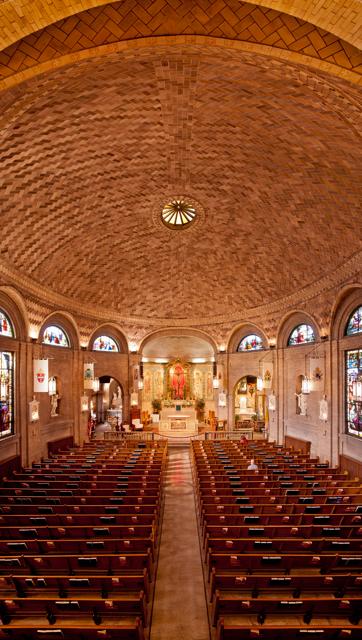
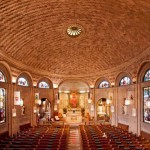
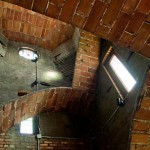
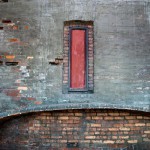
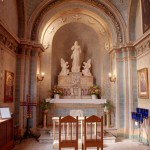

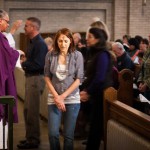
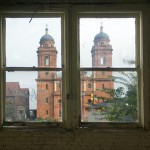
let’s stop all this and just give the lot to the farmer’s of Buncombe county for a permanent farmer’s market. We could really help those folks in Battery Park and the Vanderbilt eat more healthy diets. We also need a way to stop having to haul all those tents and tables around every week in order to move our produce on a retail level. It’s way past time our farms had a dedicated space to market.